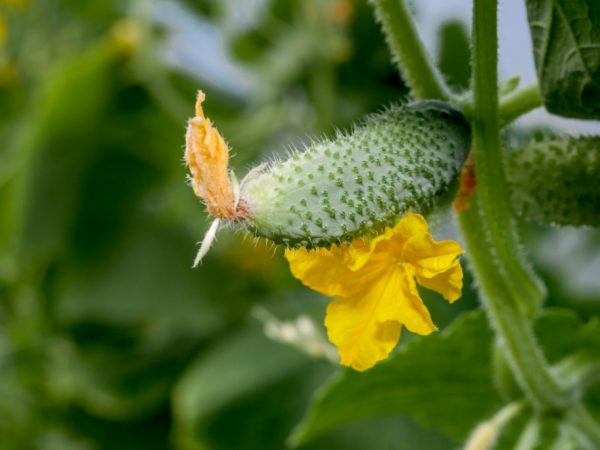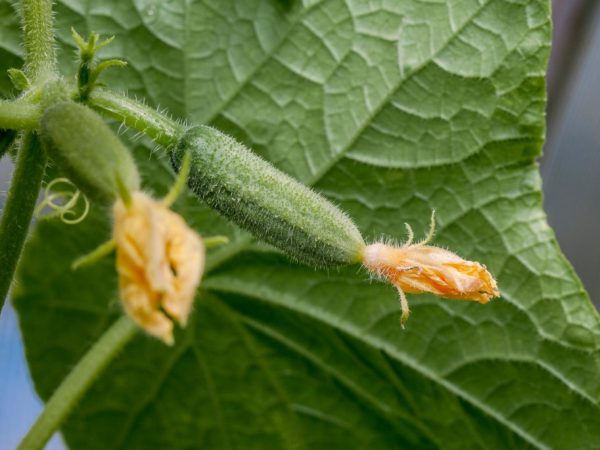Characteristics of Bettina cucumbers
Cucumbers are popular among vegetable crops. Their cultivation is widespread both on an industrial level and in private plots. Cucumber Bettina F1 has many positive characteristics due to its hybrid origin.

Characteristics of Bettina cucumbers
The variety was developed with the aim of obtaining maximum yield under unfavorable conditions. This factor contributes to the fact that plants show high resistance to the most common diseases and at the same time require minimal maintenance.
Variety characteristic
Cucumbers Bettina F1 have a number of features characteristic of this type of plant:
- Zelentsy taste less pleasant than the fruits of other salad varieties. That is why they are used mainly for industrial purposes, for factory preservation.
- Harvesting takes place on day 42. This culture belongs to the category of early maturing species.
- The amount of marketable output in fruits reaches 5 kg per 1 m².
Bettina cucumbers are suitable for both open and closed cultivation. It is recommended to germinate the seeds before planting in the ground. The seedling method will accelerate fruit formation and strengthen the bushes. Also, when planting this type, you can use trellises. This will make it easier to care for the lashes and increase yields.
The culture thrives best in mild climates, but at the same time tolerates small temperature fluctuations. Due to the minimum requirements for care and growth conditions, the variety can be used as an indoor variety (grown on a windowsill or a warm balcony).
Description of the bush
Medium branched weave, the main stem is indeterminate. The female flowering type is characteristic of hybrid plant species. The number of fertile nodes (ovaries) ranges from 1 to 3 in the leaf sinuses.
The foliage is light green, the size of the plates is average in open field conditions, increased in greenhouse growing conditions. The nodes form from 2 to 4 zelents.
Description of fruits
The price for cucumbers of this variety depends on their appearance. The crop for sale must have the following characteristics:
- fruit length - 10-12 cm;
- diameter - 3 cm;
- average weight - 70 g.
Bettina F1 cucumber pulp lacks cavities and bitterness. The crispy texture is not lost after salting. The shape of the fruit is cylindrical. Seeds are underdeveloped or out of stock.
The surface is medium lumpy, with white spines. The color of the peel is predominantly dark green, in some cases, depending on soil conditions and watering, yellow spots or stripes may appear. This color is considered the norm in soil with a high content of natural acids. The variety is grown for the purpose of obtaining gherkins. Optimal harvesting scheme: 1 time in 2-3 days.
Culture care
F1 series hybrids have good stress resistance and are easy to care for. However, the organization of favorable conditions allows you to grow a crop of the highest quality. Bushes need:
- watering;
- timely feeding;
- weeding;
- lash formation.
Watering

You need to water it in the morning with warm water
The amount of moisture consumed depends on the growth period of the bushes. Before the flowering period, the norm will be: about 6 liters of liquid per 1 m² in drought conditions and 4 liters for the same area in temperate climates. Ripening of zelents affects the needs of the crop for liquid. The rate should be increased to 9 liters 1 m² in drought conditions and to 6 liters in temperate climates.
Bettina cucumbers require breathable soil and can abruptly stop growing and die if the top ball of soil dries up and becomes crusty. After watering, the soil must be fluffed up (dug up). However, hilling should be done carefully, since the root system of these plants is dangerously close to the surface of the site.
Watering is recommended in the morning with warm water. At night, excess moisture in the ground can lead to hypothermia of the roots.
Top dressing
Top dressing is applied once during the growth period, in the second week of the growing season. The variety accepts nitrogen and potash fertilizers well. You can also additionally feed the plants with mixtures prepared at home:
- onion infusion;
- serum solution with added iodine;
- bird droppings diluted in water.
In addition, irrigation water can be enriched. For 10 liters of liquid, 10 g of urea is diluted.
Bush formation
Bushes of this variety do not need serious adjustment of the lashes with an open growing method. For a good harvest, 2-3 lower shoots should be cut off. The central stem should remain intact - it is on it that the greens are formed.
In cases where cucumbers are grown in a closed greenhouse, lashing and pruning plays an important role during the period of intensive growth. When the main stem reaches the top of the trellis, it must be stopped. It is important not to intertwine the stems very densely, otherwise they will interfere with each other.
Weeding
Depending on how quickly the area with cucumbers is overgrown with weeds, weeding should also take place. It is worth not forgetting that if the lashes are not tied up, they quickly cover the soil around the main stem and drown out and the weed does not grow there. But if the lashes are tied up, the overgrowth of the soil with grass is more intensive. In order not to start the site, weeding is carried out once a week.
Diseases and pests
The Bettina F1 species has an innate immunity to common diseases. However, timely prevention will help to finally reduce the risk of disease.
Early ripening varieties are not processed with heavy chemistry, as this can lead to the toxicity of the zelents. Solutions of organic and mineral origin help prevent diseases:
- Powdery mildew will not touch bushes that are treated with a mixture of milk, iodine and soap. The solution should be applied to the leaves of the crop.
- Gray root rot is vulnerable to water with added baking soda.
- The bacteriosis is not dangerous for plants that have been treated with trichopolum. For 1 liter of water, 2 tablets should be diluted.
Insects are capable of causing more harm to greens than disease. Slugs and spider mites are especially dangerous. To get rid of pests, you need to dig up the garden in the fall and leave the soil to freeze.
You can plant garlic and onions between the rows. This will ward off many pests from the site.
The seeds should be calcined immediately before germination. Cucumber kernels do not need to be soaked, but they can be treated with potassium or sulfate solution for better growth.
Conclusion
Cucumber Betina F1 is a self-pollinating hybrid. The description of this type of culture contains many positive qualities.
Early maturity and good keeping quality make this Dutch variety competitive in the market. Disease resistance and high yields should also be noted.


